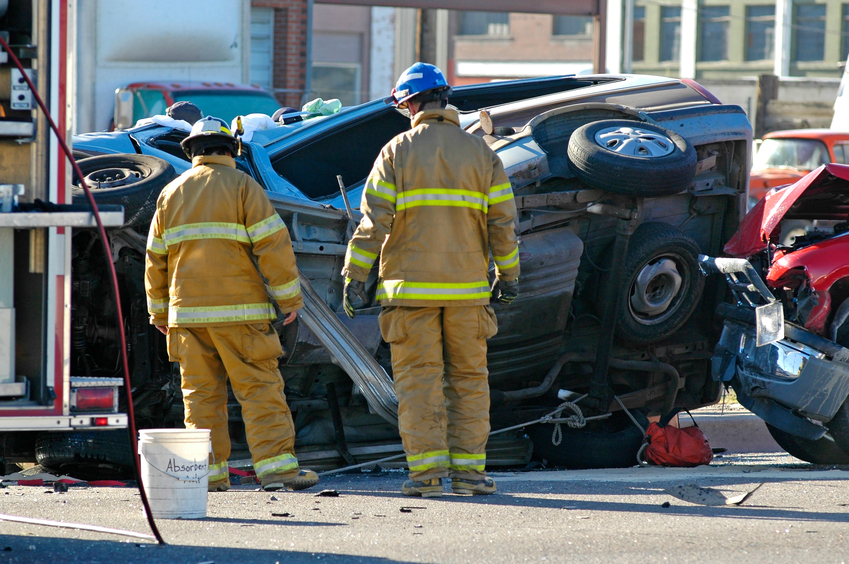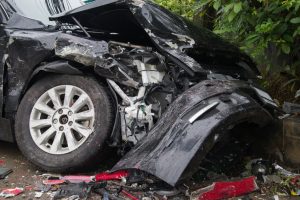If you or a loved one was involved in a rollover accident, we can tell you that we know how scary a rollover can be. If another party was at fault in the car accident we’re here to help answer any questions you may have.
Connecticut is a beautiful state. Unfortunately, our beautiful roads and foliage often cause “tripping” of an automobile, leading to what can be a devastating crash. Tripping occurs typically when a vehicle leaves a roadway and comes in contact with a soft shoulder, such as dirt or grass, resulting in one or more of the wheels digging into the earth and cause the car to rollover.
Rollovers are common, and according to the National Highway Transportation Safety Administration (NHTSA), approximately 33% of rollover accidents may involve a fatality, especially if a seat belt was not being worn.
Rollovers are Often Single Car Accidents

According to the NHTSA, 95% of rollover accidents are typically involving a single car, and again, most are involved with an automobile leaving the roadway. If you were an occupant in the vehicle, you have rights that need to be protected.
Speeding and alcohol are contributors to rollover accidents. While these are illegal reasons, Connecticut’s roads and highways have many turns, rises, and driving conditions can be made dangerous due to inclement weather such as rain or snow.
Due to the nature of a rollover incident, the accident injuries most commonly associated can take a greater amount of time to heal. These include but are not limited to head, neck, and spinal injuries.
How Can The Flood Law Firm Help?
We cannot stress the severity of injuries that may be caused during a rollover – they can be catastrophic. Symptoms of a headache may actually be a result of mild brain trauma. If you have pain in the head, neck, or spinal area we recommend you seek medical attention immediately.
Legal tip: Your rights are limited by a time frame known as a statute of limitations. If a car has been involved in a rollover, an insurance company may quickly begin the process of disposing of the car which means evidence could be lost.
Beginning the process of meeting with a lawyer is easy. We offer free consultations and can at the very least make you aware of your rights under Connecticut laws. Should you chose to hire our firm we work on a contingency-fee-basis which means there are no up-front fees and you only pay us if we recover on your behalf.
Injuries from Rollover Crashes

Injuries sustained in a rollover crash can be much more serious than those sustained in other types of vehicle accidents for several reasons. First, nearly 70 percent of rollover fatalities occur to passengers who are not wearing a seat belt. Without some way to restrain their bodies during the rollover, the passengers’ bodies are bumped, twisted, and thrown around the interior of the vehicle during the flip, often followed by ejection from the vehicle.
According to the National Automotive Sampling Systems Database, the head and neck are the most common injuries sustained during a rollover crash, with brain injuries causing fatalities in 54 percent of cases. Other injuries include the neck (thorax), abdomen, upper limbs, and lower limbs.
In most cases, survivors of rollover crashes sustain multiple injuries that can require long-term medical intervention and rehabilitation. It is not uncommon for victims of these types of crashes to sustain internal bleeding, broken bones, head trauma, and spinal cord injuries. These can all cause a variety of long-term effects, including memory loss, difficulty speaking, motor function loss, paralysis, chronic pain, permanent nerve damage, and more.
Rollover Car Accident Statistics
The U.S. Department of Transportation records about 9 million car accidents every year in the United States. While only 2 percent of those crashes involve vehicles that rollover, this type of accident accounts for 35 percent of all vehicle deaths reported each year. That makes automobile rollover crashes the deadliest of all types of car accidents. To make matters worse, nearly 70 percent of those deaths occur in passengers who were not wearing a seat belt. This indicates that many of the deaths reported could have been prevented.
As one of the worst kinds of car crashes to be involved in, rollover statistics offer a few clues as to what caused them and how they can be prevented. What do you need to know about rollover deaths? Here are a few startling statistics to consider:
- SUVs and lightweight trucks are most commonly involved in this type of deadly crash
- One-third of all vehicle fatalities in the United States involve a rollover crash
- 69 percent of rollover fatalities involve passengers who were not wearing seat belts
- Most rollover crashes occur on rural roads that lack lane dividers
- The majority of rollover crashes involve a male driver under the age of 40
- 95 percent of rollover accidents are single-vehicle accidents
How Rollover Car Accidents Happen
Rollovers are violent crashes. They often occur when the driver loses control of the vehicle because of environmental conditions that may or may not be out of his or her control. Although most rollover crashes occur in vehicles that have a higher center of gravity (such as an SUV or truck), the style of the vehicle does not seem to be a prevailing factor in causing the actual crash; instead, it simply increases the likelihood that once the driver does lose control of the vehicle, it is more likely to flip over before it comes to rest.
So what are some of the factors that cause these deadly crashes? According to the National Center for Statistics and Analysis Research and Development (NHTSA), tripping is the main cause of these deadly crashes. According to statistics gathered by the group’s research, 95 percent of all rollover crashes are caused when the vehicle trips (or leaves) the roadway. This can be from something as simple as the vehicle veering off the road onto a softer patch of ground along the edge of the roadway, hitting a curb, or even smacking into a guardrail. No matter what the initial cause, once the vehicle leaves the hard-packed roadway, it loses control and overturns. But what can make a car suddenly veer off the side of the road on its own? Here are some of the factors that researchers have discovered as the cause of many of these kinds of crashes:
But what can make a car suddenly veer off the side of the road on its own? Here are some of the factors that researchers have discovered as the cause of many of these kinds of crashes:
- Speed: Fatal rollover crashes are more often speed-related than fatal non-rollover crashes, according to NHTSA research. It has been reported that about 40 percent of all fatal rollover crashes involved excessive speeds, with 75 percent or more of these fatal crashes involving speeds over 55 mph.
- Alcohol: More than half of all fatal rollover crashes involve some degree of alcohol, although not all involve an intoxicated driver. Even a small amount of alcohol can impair a driver’s ability to retain control of the vehicle, thus increasing the risk of a rollover crash.
- Weather/Road Conditions: Rain, sleet, snow, and even high winds can all contribute to a driver’s loss of control of the vehicle, causing a rollover accident.
- Location: Rural roads experience more rollover crashes than their busier counterparts. Some reasons may be because rural roads are darker, limiting the driver’s ability to see the roadway clearly; they do not contain lane barriers; are often curvier and less populated, which allows drivers to increase their speed; and may offer more opportunity for animals to obstruct the driver on the roadway.
- Driver distraction: 90 percent of rollover accidents occur either on straight roadways or during a turn. This indicates that driver distraction may be a culprit.
- Driver behavior: With 85 percent of all rollover-related fatalities linked to single-vehicle crashes, researchers believe that driver behavior plays a significant role in this type of crash.
Contacting an Accident Attorney After a Rollover
The first thing to do after being involved in a rollover crash is to seek appropriate medical care. Even if you do not think you are hurt, it is important to seek medical attention since some injuries can worsen over time. Report the accident to the authorities and have all of the information regarding the accident documented. Your insurance company will need this information to take care of any claims filed.
Next, it is vital to contact an attorney who is experienced in handling these types of crashes, especially if serious injuries or deaths have occurred.
The staff at The Flood Law Firm are trained in helping victims of rollover crashes and can help you maneuver the complicated procedures that may follow such an accident. Whether you need help negotiating with the insurance company to get your claims settled quickly and fairly, or you need assistance handling serious legal issues regarding the crash, our professional attorneys are ready to lend a hand.
No one should have to face the consequences of a serious rollover crash alone. The trial attorneys at The Flood Law Firm can help evaluate the merits of your claim and offer guidance on moving forward. Ensure that you get the help you need in receiving compensation for your medical expenses, property damages, lost wages, and pain and suffering by letting one of our lawyers take your case. Consultations are always free at The Flood Law Firm. Make an appointment today to come in and discuss your case with our professional legal team. To find out more, be sure to contact us.
